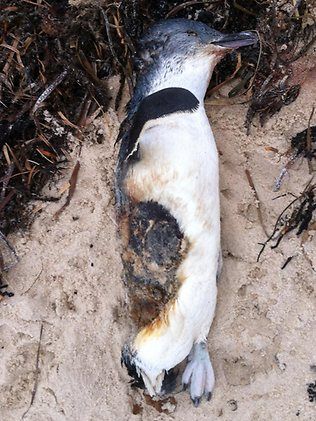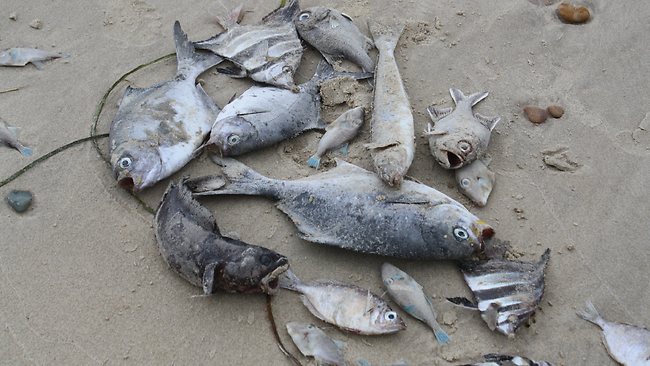
SA Health told The Advertiser algal blooms, found across the state's coastline most likely due to March's prolonged hot weather and heavy winds, did not affect human health in any way.
"Consumption of fish caught alive do not represent health concerns, however SA Health advises fish caught dead should not be eaten due to concerns over decomposition and spoilage," a spokeswoman said yesterday.
The assurance comes as a taskforce of experts today start testing water to help solve the mystery of the thousands of dead fish and 16 dead dolphins.
The Fisheries Department, Environmental Protection Authority and SA Water will lead the taskforce, which will also conduct tests on the fish and some of the dolphins.
Several other nations around the world have also experienced unexplained mass sea deaths in recent months.
Scientific experts from SA Museum conducted autopsies on two dead dolphins yesterday, but said they were still stumped as to how and why such large numbers died in recent weeks.
SA Museum senior researcher of mammals Dr Catherine Kemper said the dolphin samples would be sent to pathology for further analysis. She said preliminary analysis showed one of the dolphins was heavily bruised.
"It had lots of bruising on it which means for some reason something bumped it or it bumped itself very badly," she said.
Pathology results on a dolphin autopsy conducted last week found E coli near the dolphin's blowhole, which Dr Kemper said was an unusual spot to find the bacteria.
Biosecurity SA manager of aquatic pests Vic Neverauskas said yesterday he believed algal blooms were most likely the cause of toxins in the water, which affected the small fish.
Greens MLC Mark Parnell said he believed the State Government needed to determine the cause of the deaths as soon as possible.
"We need to quickly discover if human action - be it through the desal plant or dumping waste water and dirty stormwater - is in any way to blame, and swiftly respond," he said.
Fisheries Minister Gail Gago, Biosecurity SA and the EPA ruled out any possible link to the desalination plant.
The Dolphin Trauma Group did not have the resources to carry out the extra tests and Dr Kemper planned to ask State Government agencies for help to investigate the cause.
Biosecurity SA had paid for bacterial testing for three dolphins found at KI, but because the samples were frozen, the results were inconclusive, she said.
Dr Kemper said three post-mortems of dolphins found at Maslin Beach, North Haven and Outer Harbor would be conducted this week.
Whale and Dolphin Conservation Society science and education manager Dr Mike Bossley urged the State Government to set up a cross-departmental taskforce to investigate.
He said there was not enough co-operation between those investigating dolphin deaths, algal blooms and washed-up fish.
Dr Bossley said the cost to perform tests - particularly for dolphins - also was a problem.
"I'm concerned for two reasons - one is that the (deaths) are quite high and secondly, that we still don't have any real idea of what's causing it," he said.
"There must have been 10 different species washed up at Adelaide beaches to the south."
State Government scientists are testing dead fish for signs of algae to prove their suspicions it has caused the spate of dead marine life washing up on Adelaide beaches.
The majority of dead fish have been found at Moana, Moana South, O'Sullivans Beach and Christies Beach. Others have washed up at Semaphore, Seacliff and on the Eyre Peninsula.
Sunday Mail fishing columnist Jon Huie described the spate of deaths at southern beaches as the worst he had seen in his 40 years along the coastline.
"I'm concerned for two reasons - one is that the (deaths) are quite high and secondly, that we still don't have any real idea of what's causing it," he said.
"There must have been 10 different species washed up at Adelaide beaches to the south."
State Government scientists are testing dead fish for signs of algae to prove their suspicions it has caused the spate of dead marine life washing up on Adelaide beaches.
The majority of dead fish have been found at Moana, Moana South, O'Sullivans Beach and Christies Beach. Others have washed up at Semaphore, Seacliff and on the Eyre Peninsula.
Sunday Mail fishing columnist Jon Huie described the spate of deaths at southern beaches as the worst he had seen in his 40 years along the coastline.
Mr Neverauskas said he retrieved "fresh" samples on Monday and hoped results would be in over the coming days.
Scientists are also taking water samples.
Mr Neverauskas said the fact the majority of dead fish were small, shallow-water species - coupled with signs of irritated and swollen gills - strongly suggested an algal bloom was to blame.
Algal blooms - caused by a hotter-than-usual March - deplete oxygen in the water and cause fish to die.
Flinders University marine biology expert Professor Peter Fairweather said the odd fish being washed up along a stretch of coastline was not unusual.
But he said speculation had risen due to the rare clusters of smaller dead fish, causing beachgoers to send in anything they saw.
"It is not unusual to find dead penguins around - they're always under stress," he said.
Mr Fairweather said he had heard similar reports interstate.
"It's not just in the Gulf here so I'd be really, really surprised if it was the desalination plant," he said.
However, oceanographer Jochen Kaempf said it was possible increased oxygen and salinity levels caused by discharge from the desalination plant could be responsible for the deaths.
Dead fish
He said discharge from the plant was not adequately monitored and that he had previously warned the State Government desalination discharge had the potential to create "death zones" of several kilometres.
Adelaide Now readers have engaged in a spirited debate over the cause of the deaths.
Many have voiced suspicions the newly opened desalination plant at Port Stanvac is to blame.
Others have suggested sea pollution, an underwater volcano or irradiated water from the Fukushima nuclear plant in Japan.




Reader Comments
to our Newsletter